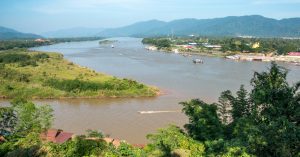The synthetic drug market in East and Southeast Asia continues to expand at “concerning levels,” the United Nations said yesterday, highlighting the emergence of new smuggling routes for methamphetamine and a spike in the production of ketamine.
In its annual report on the Asian synthetic drug market, the U.N. Office on Drugs and Crime (UNODC) stated that the region’s drug trafficking syndicates, many based in the Golden Triangle of mainland Southeast Asia, were becoming increasingly creative in how they scaled up production and trafficking in order to anticipate and evade government crackdowns.
“The drug trafficking and production situation has become increasingly complex,” Masood Karimipour, UNODC Regional Representative for Southeast Asia and the Pacific, said in a statement accompanying the report’s release. He said that organized crime groups were “lowering the production costs and scaling up production by using non-controlled chemicals.” This has led to more large-scale shipments and “further price drops as availability and affordability increase.”
As in past years, the surge has been led by methamphetamine. A record 190 tons of the drug was seized in the region last year, the UNODC reported, 89 percent of it in Southeast Asia. Coming after seizures of 151 tons in 2022 and 171.5 tons in 2021, this caps off a decade that has seen a more than fourfold increase in seizures of the drug.
“The record volume of seizures, along with overall decreases in price and stable or increased average purities, are clear signs that the scale of production and trafficking of methamphetamine from the Golden Triangle has significantly increased,” the report stated. At the same time, “a large majority of countries” in the region have reported increases in methamphetamine use, suggesting that the amount of the drug getting through to the street far exceeds the amount seized by anti-drug authorities.
Reported seizures of ketamine declined slightly from 29 tons in 2022 to 23.3 tons in 2023, but “remains at a significantly high level compared to the years prior,” the UNODC stated.
As in the past, most synthetic drug production continues to take place in Myanmar’s Shan State, particularly in the state’s “special regions” run by rebel groups like the United Wa State Army and the National Democratic Alliance Army, which have partnered with organized crime groups. This region of eastern Myanmar boasts a number of advantages, including the region’s fractured state jurisdictions and proximity to China and Southeast Asian drug and precursor markets.
While Shan remained the epicenter of synthetic drug production in 2023, the UNODC report noted, “the illicit manufacture of synthetic drugs is expanding to neighboring countries.”
The UNODC report also highlighted the increasing sophistication, creativity, and flexibility of organized crime groups operating in the region, which have not rested on their laurels amid the rapid expansion of the Asian drug trade.
These syndicates have considerably “expanded their options” in terms of how they manufacture synthetic narcotics and minimize disruptions to their supply chains. The UNODC noted that the past year has seen a continued shift from the use of tightly controlled precursor chemicals to diversified types of chemicals including non-controlled pre-precursors and bespoke precursor chemicals that are easier to obtain. The UNODC reported that “record quantities of non-controlled chemical seizures were reported in the region in 2023, amounting to nearly 700 tons of various substances,” vastly outweighing the reported seizures of scheduled chemicals.
“The emerging use of non-controlled chemicals is a major concern for the region in addressing these challenges,” Reiner Pungs, UNODC’s lead drugs expert for Southeast Asia, said in the statement published alongside the report. “An effective response will require investments in both regulatory frameworks and enforcement capacities, and more active monitoring of the legal chemical trade.”
Drug trafficking groups are also increasingly using maritime routes through the Gulf of Thailand and the Andaman Sea to traffic large quantities of drugs to global markets, as evidenced by recent “numerous seizures of methamphetamine” exceeding one ton, often “alongside large quantities of ketamine.”
While the region’s anti-drug authorities will no doubt keep up the rapid clip of seizures, the political economy of the region’s drug production is unlikely to shift any time soon. The conflict that has followed the 2021 coup in Myanmar has strengthened the country’s centrifugal political tendencies, empowering the independent armed groups and organized crime syndicates that are responsible for the vast majority of the region’s synthetic drug production. Without an enduring solution to the country’s conflict and the state-building challenges that underpin it – something that appears remote, even after three years of intensified civil war – it is hard to see the region’s governments taking any more than palliative action to stem the current drug crisis.
































